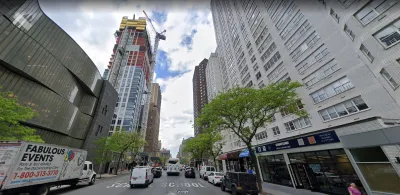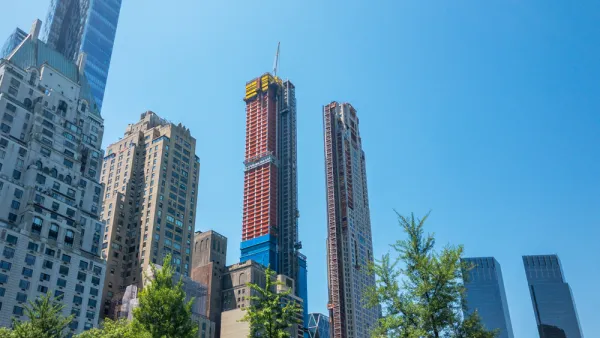The new skyscraper being built at 200 Amsterdam Avenue in Manhattan might be forced by an appeals court to remove 20 floors of the mostly complete building.

"Now that the 52-story tower at 200 Amsterdam Avenue is almost done, it may soon have to be partly undone, like a construction film running in reverse," writes Justin Davidson.
The building's final height is subject to a case currently underway in appeals court, with as many as 20 stories, already mostly built, hanging in the balance.
All of the confusion, according to Davidson, is thanks to New York's inscrutable zoning code, and the building's location on a "bizarre knot" of parcels.
Complexity favors developers equipped with expensive legal advice, which is how SJP Properties persuaded the Department of Buildings to issue a permit for a 668-foot spear sticking into the flank of the Upper West Side. The narrow, stretched-out tower designed by Elkus Manfredi reaches its kinda–sorta–neo–Art Deco–ish crown via a series of setbacks that make it look like a staircase in the wrong aspect ratio. Any tall building can unleash the usual It’s out of character! versus More housing now! shoutfest, but this one has turned area residents into self-appointed land-use experts.
As detailed in the history provided here by Davidson, the unbuilding of skyscrapers happens with some frequency in New York, and this wouldn't be the first time a building has had to lop its top off. That's where those with even a passing interest in the science and art of building might be interested in this case study. "In a city too packed for implosion or wrecking balls, disassembling an entire structure is slow and dangerous work, planned by specialized engineers," according to Davidson.
FULL STORY: How Do You Chop 20 Stories Off a Too-Tall Building?

National Parks Layoffs Will Cause Communities to Lose Billions
Thousands of essential park workers were laid off this week, just before the busy spring break season.

Retro-silient?: America’s First “Eco-burb,” The Woodlands Turns 50
A master-planned community north of Houston offers lessons on green infrastructure and resilient design, but falls short of its founder’s lofty affordability and walkability goals.

Delivering for America Plan Will Downgrade Mail Service in at Least 49.5 Percent of Zip Codes
Republican and Democrat lawmakers criticize the plan for its disproportionate negative impact on rural communities.

Test News Post 1
This is a summary

Test News Headline 46
Test for the image on the front page.

Balancing Bombs and Butterflies: How the National Guard Protects a Rare Species
The National Guard at Fort Indiantown Gap uses GIS technology and land management strategies to balance military training with conservation efforts, ensuring the survival of the rare eastern regal fritillary butterfly.
Urban Design for Planners 1: Software Tools
This six-course series explores essential urban design concepts using open source software and equips planners with the tools they need to participate fully in the urban design process.
Planning for Universal Design
Learn the tools for implementing Universal Design in planning regulations.
EMC Planning Group, Inc.
Planetizen
Planetizen
Mpact (formerly Rail~Volution)
Great Falls Development Authority, Inc.
HUDs Office of Policy Development and Research
NYU Wagner Graduate School of Public Service





























